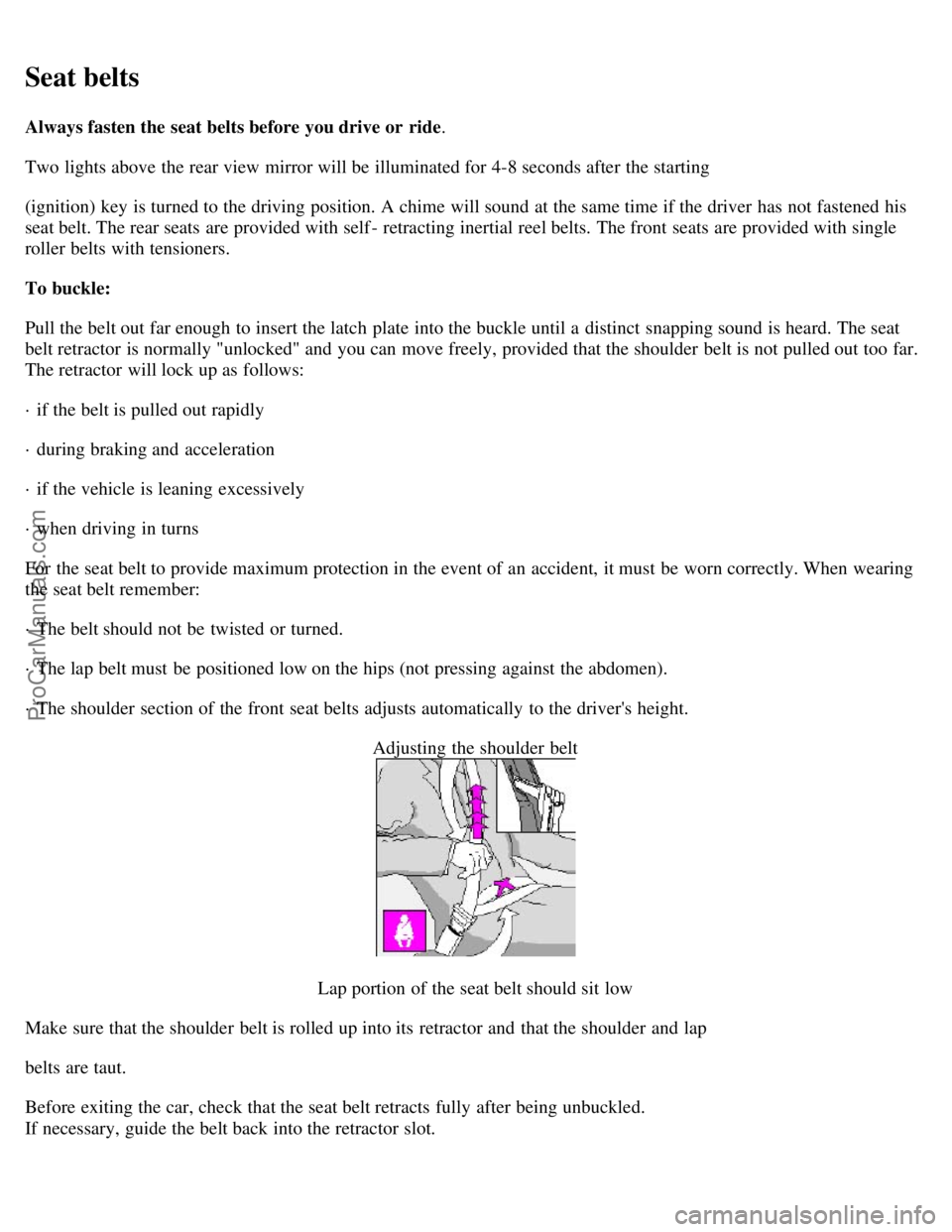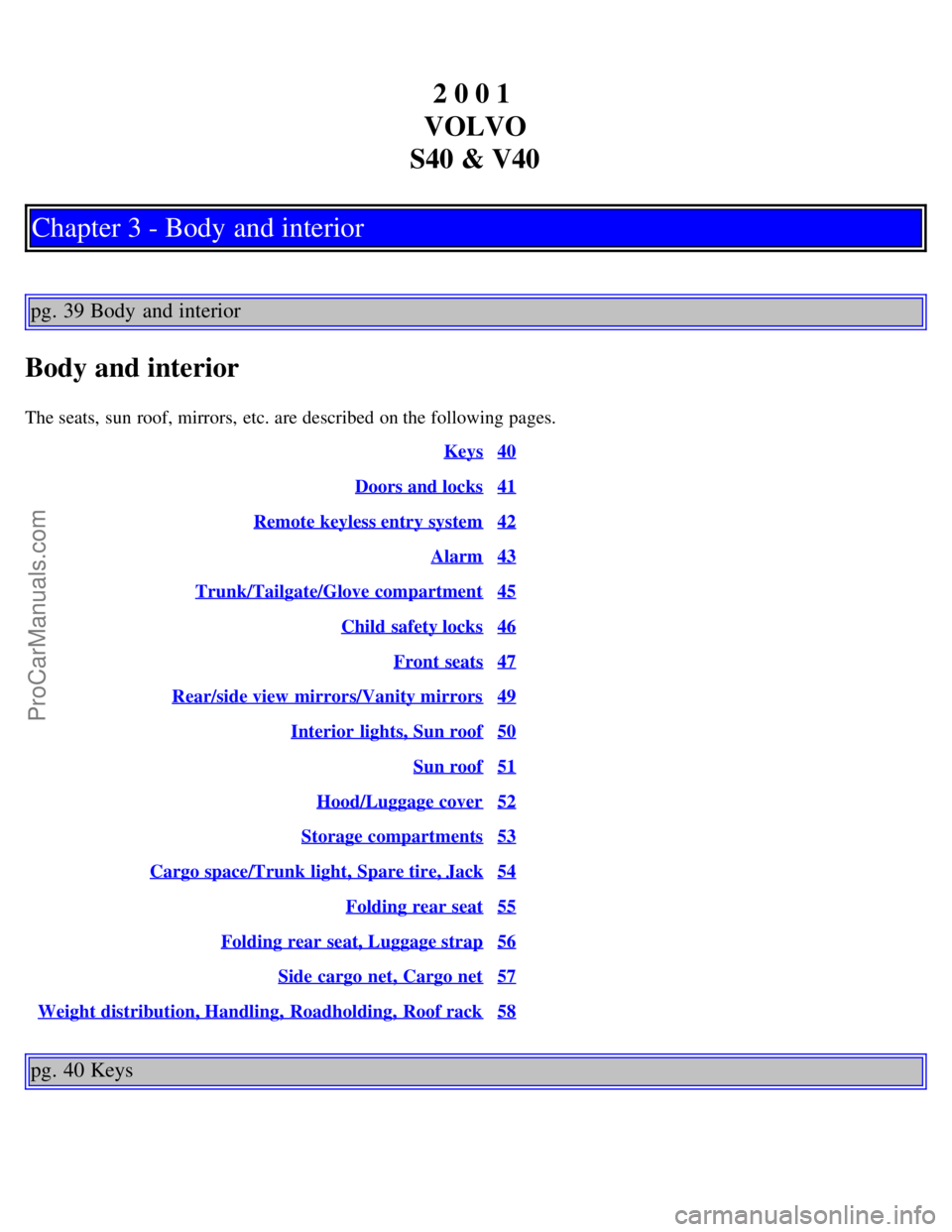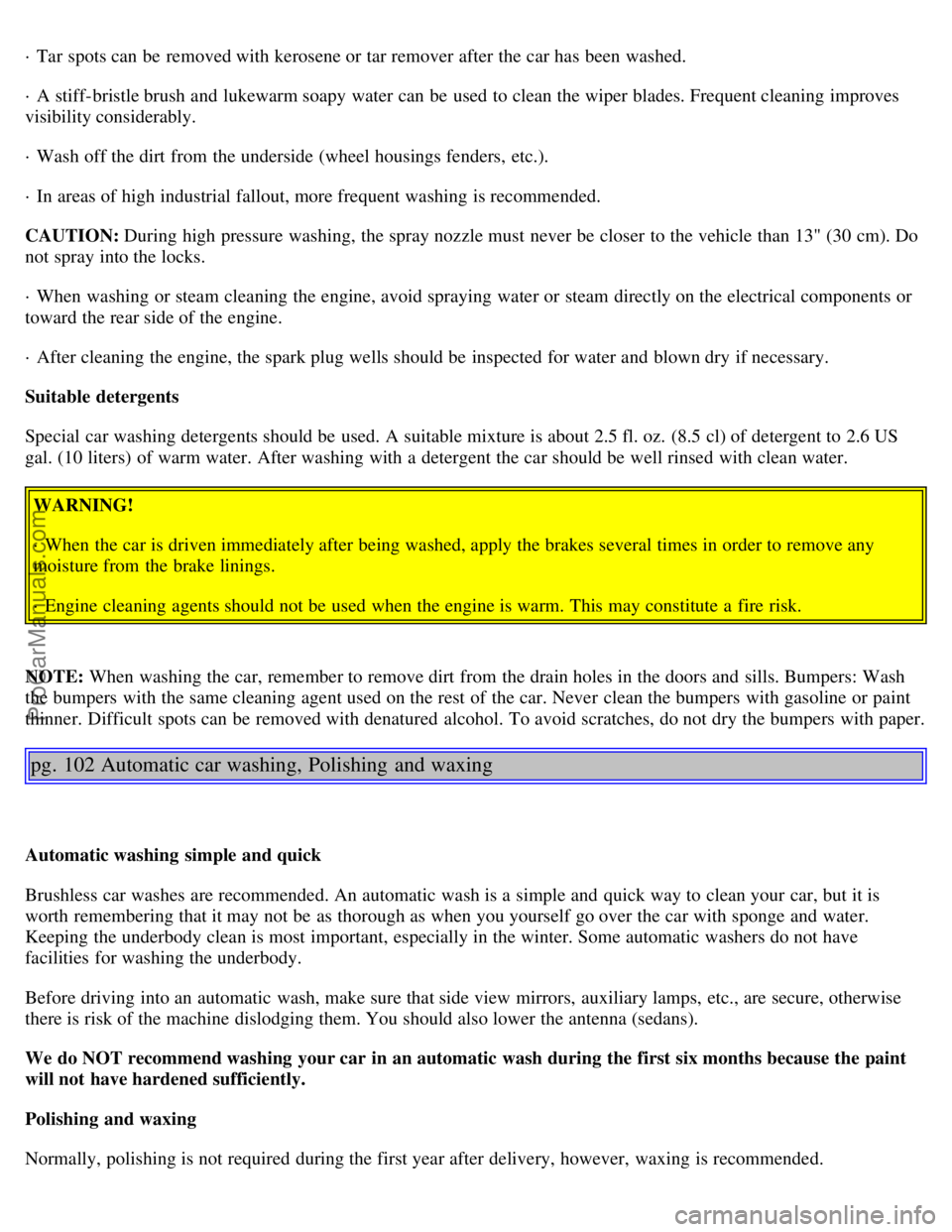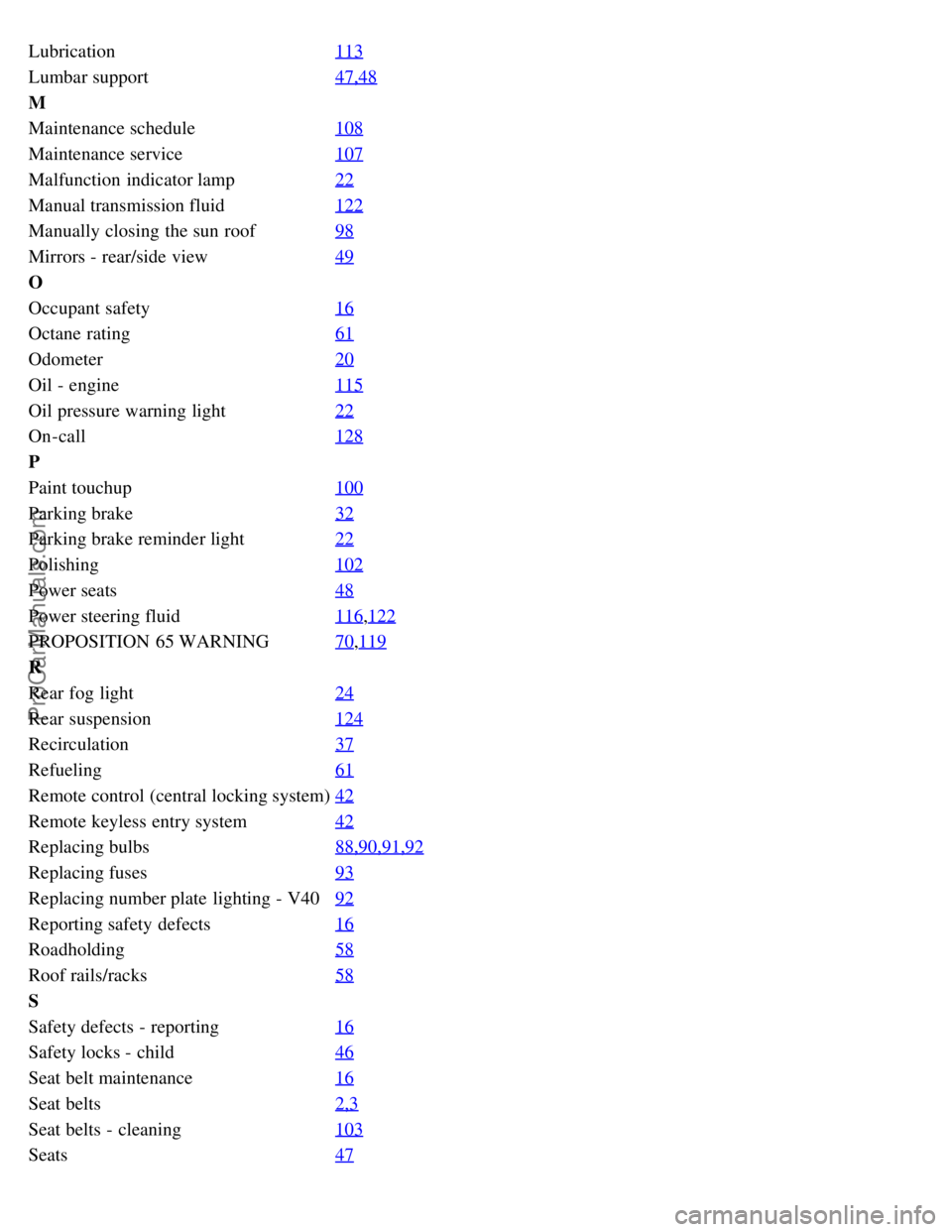rear view mirror VOLVO V4 2001 Owners Manual
[x] Cancel search | Manufacturer: VOLVO, Model Year: 2001, Model line: V4, Model: VOLVO V4 2001Pages: 87, PDF Size: 2.34 MB
Page 6 of 87

Seat belts
Always fasten the seat belts before you drive or ride.
Two lights above the rear view mirror will be illuminated for 4-8 seconds after the starting
(ignition) key is turned to the driving position. A chime will sound at the same time if the driver has not fastened his
seat belt. The rear seats are provided with self - retracting inertial reel belts. The front seats are provided with single
roller belts with tensioners.
To buckle:
Pull the belt out far enough to insert the latch plate into the buckle until a distinct snapping sound is heard. The seat
belt retractor is normally "unlocked" and you can move freely, provided that the shoulder belt is not pulled out too far.
The retractor will lock up as follows:
· if the belt is pulled out rapidly
· during braking and acceleration
· if the vehicle is leaning excessively
· when driving in turns
For the seat belt to provide maximum protection in the event of an accident, it must be worn correctly. When wearing
the seat belt remember:
· The belt should not be twisted or turned.
· The lap belt must be positioned low on the hips (not pressing against the abdomen).
· The shoulder section of the front seat belts adjusts automatically to the driver's height. Adjusting the shoulder belt
Lap portion of the seat belt should sit low
Make sure that the shoulder belt is rolled up into its retractor and that the shoulder and lap
belts are taut.
Before exiting the car, check that the seat belt retracts fully after being unbuckled.
If necessary, guide the belt back into the retractor slot.
ProCarManuals.com
Page 23 of 87

2 0 0 1
VOLVO
S40 & V40
Chapter 3 - Body and interior
pg. 39 Body and interior
Body and interior
The seats, sun roof, mirrors, etc. are described on the following pages. Keys
40
Doors and locks41
Remote keyless entry system42
Alarm43
Trunk/Tailgate/Glove compartment45
Child safety locks46
Front seats47
Rear/side view mirrors/Vanity mirrors49
Interior lights, Sun roof50
Sun roof51
Hood/Luggage cover52
Storage compartments53
Cargo space/Trunk light, Spare tire, Jack54
Folding rear seat55
Folding rear seat, Luggage strap56
Side cargo net, Cargo net57
Weight distribution, Handling, Roadholding, Roof rack58
pg. 40 Keys
ProCarManuals.com
Page 54 of 87

· Tar spots can be removed with kerosene or tar remover after the car has been washed.
· A stiff-bristle brush and lukewarm soapy water can be used to clean the wiper blades. Frequent cleaning improves
visibility considerably.
· Wash off the dirt from the underside (wheel housings fenders, etc.).
· In areas of high industrial fallout, more frequent washing is recommended.
CAUTION: During high pressure washing, the spray nozzle must never be closer to the vehicle than 13" (30 cm). Do
not spray into the locks.
· When washing or steam cleaning the engine, avoid spraying water or steam directly on the electrical components or
toward the rear side of the engine.
· After cleaning the engine, the spark plug wells should be inspected for water and blown dry if necessary.
Suitable detergents
Special car washing detergents should be used. A suitable mixture is about 2.5 fl. oz. (8.5 cl) of detergent to 2.6 US
gal. (10 liters) of warm water. After washing with a detergent the car should be well rinsed with clean water.
WARNING!
· When the car is driven immediately after being washed, apply the brakes several times in order to remove any
moisture from the brake linings.
· Engine cleaning agents should not be used when the engine is warm. This may constitute a fire risk.
NOTE: When washing the car, remember to remove dirt from the drain holes in the doors and sills. Bumpers: Wash
the bumpers with the same cleaning agent used on the rest of the car. Never clean the bumpers with gasoline or paint
thinner. Difficult spots can be removed with denatured alcohol. To avoid scratches, do not dry the bumpers with paper.
pg. 102 Automatic car washing, Polishing and waxing
Automatic washing simple and quick
Brushless car washes are recommended. An automatic wash is a simple and quick way to clean your car, but it is
worth remembering that it may not be as thorough as when you yourself go over the car with sponge and water.
Keeping the underbody clean is most important, especially in the winter. Some automatic washers do not have
facilities for washing the underbody.
Before driving into an automatic wash, make sure that side view mirrors, auxiliary lamps, etc., are secure, otherwise
there is risk of the machine dislodging them. You should also lower the antenna (sedans).
We do NOT recommend washing your car in an automatic wash during the first six months because the paint
will not have hardened sufficiently.
Polishing and waxing
Normally, polishing is not required during the first year after delivery, however, waxing is recommended.
ProCarManuals.com
Page 85 of 87

Lubrication113
Lumbar support47,48
M
Maintenance schedule108
Maintenance service107
Malfunction indicator lamp22
Manual transmission fluid122
Manually closing the sun roof98
Mirrors - rear/side view49
O
Occupant safety16
Octane rating61
Odometer20
Oil - engine115
Oil pressure warning light22
On-call128
P
Paint touchup100
Parking brake32
Parking brake reminder light22
Polishing102
Power seats48
Power steering fluid116,122
PROPOSITION 65 WARNING70,119
R
Rear fog light24
Rear suspension124
Recirculation37
Refueling61
Remote control (central locking system)42
Remote keyless entry system42
Replacing bulbs88,90,91,92
Replacing fuses93
Replacing number plate lighting - V4092
Reporting safety defects16
Roadholding58
Roof rails/racks58
S
Safety defects - reporting16
Safety locks - child46
Seat belt maintenance16
Seat belts2,3
Seat belts - cleaning103
Seats47
ProCarManuals.com